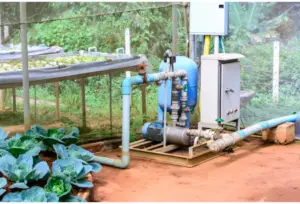
Let’s be honest, sometimes hydroponic gardening feels a little complicated. All those fancy nutrients, lights, and – of course – the pump that keeps everything flowing. But what if I told you that a simple change to how often you run your pump could make a big difference for your plants?
Think of your hydroponic pump like the heart of your system. It sends vital nutrients and water directly to your plant’s roots, keeping them happy and healthy. Getting the timing right is key – not too much, not too little. Imagine stronger roots, faster growth, and more of whatever you’re growing – whether it’s juicy tomatoes or crisp, fresh lettuce.
Ready to ditch the guesswork? In this guide, we’ll break down why your pump schedule matters. You’ll learn how to adjust it based on your plants, your setup, and get those results you’ve been working so hard for.
The Farmstand Is Your Self-Watering, Self-Fertilizing Solution for an Easy to Grow Harvest
Why Pump Timing Matters (The No-Frills Explanation)
Okay, let’s cut to the chase – why does it even matter how long your hydroponic pump runs? Think of it like this:
Food Delivery Service: Your pump is like the delivery driver for your plants’ roots. It constantly brings those yummy nutrients right to their doorstep. No pump? Those roots go hungry.
The Root’s Personal Air Supply: Your pump stirs things up, mixing oxygen into the water. Roots need to breathe just like we do! Without good oxygen levels, things get soggy and roots can get sick.
Keeping Things Clean: Stagnant water is a welcome mat for algae, mold, and other yucky stuff your plants definitely don’t want. A running pump keeps the water moving, making it way less inviting for those troublemakers.
No One-Size-Fits-All Answer (Sorry!)
Alright, here’s where things might feel a little frustrating at first. There isn’t a single magic number for how long to run your pump that works for everyone. Why? Because every hydroponic garden is a little bit different. Here’s what matters:
Your Setup: Are you growing in buckets, fancy tubes, or something else entirely? Each hydroponic system (like Deep Water Culture or those cool Nutrient Film ones) has its own needs when it comes to pump timing.
What’s Growing: Leafy greens have different needs than big, juicy tomato plants. Some plants are thirstier than others, and some love having their roots extra moist.
Space Matters: A tiny reservoir of water will need its nutrients and oxygen refreshed more often than a giant tank.
The Weather: Hot and humid days might mean your plants get thirstier, impacting how often you need that pump running.
General Starting Points (Where to Begin Your Pump Adventure)
Okay, we know there’s no single perfect answer. But don’t worry – here’s a good place to start, depending on your hydroponic system:
Deep Water Culture (DWC): Think of it like your plants are taking a relaxing bubble bath. Because the roots are always submerged, running your pump 24/7 is the way to go for maximum oxygenation. This is super important in DWC to keep those roots healthy and prevent rot.
Nutrient Film Technique (NFT): In this setup, it’s all about a steady trickle. Picture a thin stream of nutrient water constantly flowing over the roots. Short pauses (like 15-30 minutes) might be okay, but the goal is to keep the roots consistently moist without getting waterlogged.
Ebb and Flow (Flood and Drain): Think of it like the tide coming in and out. Your pump runs for a set amount of time to flood the plant roots with nutrients, then it shuts off and the water drains away. How often you flood and for how long depends on how big your plants are and how quickly your growing medium drains. Lots of short flood cycles throughout the day are common with this one.
Beyond the Basics: Drip systems, aeroponics, and other setups get a little more specialized. The same principle applies though – the pump is all about delivering the goods! A quick bit of research on your specific system is the best way to figure out the ideal timing.
Important Note: These are starting points, not hard and fast rules. Your plants will always be the best guide – keep an eye on them, and you’ll learn their perfect watering schedule!
When 24/7 Might NOT Be Ideal (Yes, Really!)
While we usually focus on how important your pump is, there are times when a break might be a good idea. Let’s break down a few scenarios:
Saving on Electricity: Hydroponics is awesome, but pumps do use electricity. While the cost isn’t huge, it adds up over time. Experimenting with short “off” intervals using a timer could save you some money. The trick is finding a balance – shorter pump cycles are okay if your plants still get everything they need.
Noise Reduction: Let’s be real, some pumps aren’t exactly silent. If your hydroponic garden is in your living room or bedroom, it might be worth turning the pump off for short breaks to get a little peace and quiet. Obviously, only do this if you’re certain your plants aren’t going to get too thirsty in the meantime!
Oversaturation Worries (Rare, but possible): Some growing mediums, like those fluffy coconut fibers, hold a ton of water. If you’re using one of those AND have your pump running really frequently, it might be too much moisture for certain plants. This isn’t super common, but something to consider if you notice things always seem soggy around those roots.
Important Notes:
Observation is KEY: If you change your pump schedule, watch your plants like a hawk. Any sign of trouble means it’s time to adjust things again.
Gradual Changes are Best: Don’t suddenly go from 24/7 to short pump cycles. Ease into it, giving your plants time to adapt.
Don’t Sacrifice Plant Health: Saving a few bucks or getting some quiet isn’t worth it if your plants suffer. Their needs come first!
Finding Your Sweet Spot (Your Plants Will Show You the Way)
So, how do you know if you’ve nailed the perfect pump schedule? The answer is simple: pay attention to your plants! They’re amazing at letting you know if they’re happy or struggling. Here’s what to watch for:
Signs of Overwatering:
Wilting or Drooping: Seems weird, right? But overly wet roots can’t take up nutrients properly, making plants look weak and droopy, just like when they’re thirsty.
Yellowing Leaves: Soggy roots = unhappy roots, and that often shows up as yellowing leaves.
Slow Growth: Your plants just seem stuck, not putting on the new growth you were expecting.
Signs of Underwatering:
Dry, Brittle Leaves: The most obvious one – those leaves feel crispy and might even crumble a bit.
Stunted Growth: Not enough water means plants can’t build new leaves or stems at their normal rate.
Wilting: Yes, wilting can be a sign of too much OR too little water. Observation is your best friend here!
Experiment and Document:
Don’t be afraid to try small adjustments to your pump schedule. Increase the run time a bit, or add an extra flood cycle if you see signs of underwatering. Cut back slightly if things look too soggy. The key is to keep a simple notebook where you jot down the changes you make and the results you see in your plants. Over time, this becomes your own personal guide to pump perfection!
Illuminating the Path to Hydroponic Success
By now, you understand that light plays a starring role in the health and productivity of your hydroponic garden. The type of plants you grow, their stage of life, and the specifics of your setup all influence the ideal amount of light.
The good news is, you don’t need a fancy degree in botany to give your plants the light they crave! Armed with the knowledge from this guide and a willingness to observe and experiment, you’ll find the perfect lighting balance for your specific hydroponic setup.
So, next time you walk by your hydroponic plants, take a moment to really look at them. Are their leaves vibrant and reaching upwards? Are flowers forming and fruits starting to swell? The answers lie under the glow of your lights!
FAQs
Q: Can I use regular light bulbs from my house?
A: You can, in a pinch. But standard household bulbs don’t have the right spectrum of light for optimal plant growth. Invest in dedicated grow lights for the best results.
Q: Do hydroponic plants need darkness?
A: Yes! While the specifics depend on the plant, most benefit from a period of darkness to carry out certain biological processes. A simple timer makes this easy.
Q: My plants are growing tall and thin – is that a light problem?
A: Very likely! This “leggy” growth is a classic sign plants are stretching desperately to reach more light. Increase intensity or duration.
Q: Will more light always lead to faster growth and more yield?
A: Not necessarily. Each plant has an optimal light range. Too much light can actually stress plants, hindering their growth or causing problems like blossom drop.
Q: What’s the easiest way to give my plants more light?
A: Start with simple adjustments! Lower your existing lights closer to the plants, add reflective materials around them, or place your setup in a sunnier window (if possible).
Q: What is the easiest way to just get started with minimal work?
A: I gotchu!
The Farmstand Is Your Self-Watering, Self-Fertilizing Solution for an Easy to Grow Harvest



